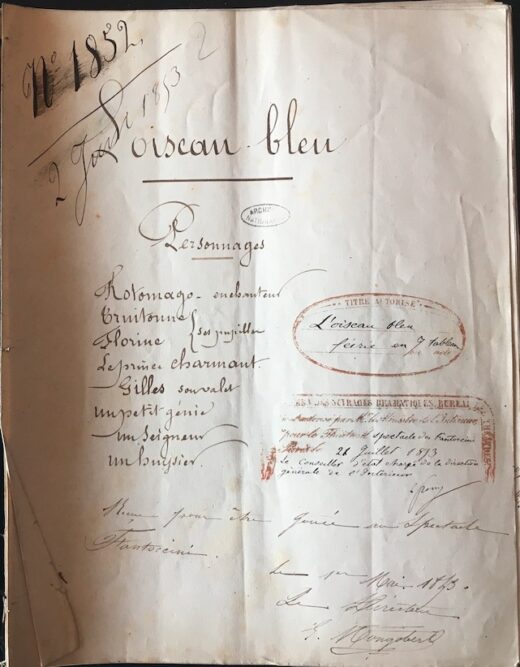
Manuscript
58 pages
L'Oiseau bleu
The manuscript of the play was submitted to the Bureau des Ouvrages Dramatiques (a French office of censorship for theatrical works) in May 1853 by Mongobert – the director of “Spectacle Fantoccini”, a small puppet theatre active between 1852 and 1854 on Boulevard du Temple in Paris (rue de Bondy, opposite the fountain known as the Château d’eau). In July 1853, the play was approved for performance. The text is kept in the French National Archives, in the “Archives de la Censure des “petits” théâtres parisiens” (Censorship Archives for “small” Parisian theatres, cote F/18/1328). No author is mentioned. Mongobert was the son of actor Gobert, who was famous for his performances in the role of Napoleon at the Théâtre de la Porte Saint-Martin.
L’Oiseau bleu is an adaptation of a homonymous play by Marie-Catherine d’Aulnoy. It was made much simpler and substantial modifications were made to the original play. For instance, Truitonne and Florine are sisters here, and while the Enchanteur is their godfather, he also plans to marry Florine.
A Prince transformed into an animal manages to marry the woman he loves
Truitonne quarrels with her sister Florine – she is unhappy with her own name and reproaches her for being loved by everyone while she is despised. She would like to inflict pain on others and to be loved anyway. Their godfather Enchanteur Rotomago (Sorcerer Rotomago) announces that he would like them to marry: Truitonne with Prince Charmant (Prince Charming) and Florine with himself. Gilles, Prince Charmant’s servant , comes in and announces Prince Charmant’s arrival, but at first the characters mistake him for his master. When Charmant arrives, he immediately notices Florine, while Rotomago tries to draw attention to Truitonne. A Fée (fairy) steps in to warn him that Florine is the woman he must love.
Rotomago bribes Gilles so that he helps him set up a trap. He will have Charmant believe that Florine has asked to see him. But taking advantage of the dark, they will make Truitonne come to the rendezvous instead. Thus, Truitonne poses as Florine and Charmant gives her a ring as a token of his love. As he believes that he is speaking to Florine, Charmant wishes out loud that a devil would carry her sister away, and his wish is fulfilled – a devil carries Florine away, but Charmant launches himself after her. Once at the cemetery, Charmant and Gilles meet an apparition of her that tells them that Florine is still alive. Rotomago asks Charmant to marry Truitonne, and when he refuses, he punishes him by changing him into a bird for seven years.
Florine is made captive in a tower under the supervision of Gilles, who has them believe that Charmant died of sorrow and of an indigestion of rum babas. A blue bird (Oiseau bleu) enters her room, and Florine understands him to be Prince Charmant. He takes hold of a cane and hits Gilles. Rotomago, Truitonne and Gilles go after Oiseau bleu. The latter comes back to Florine and receives a letter brought by a Bourdon (bumblebee), in which he is told about an attack on his kingdom. Gilles glimpses Oiseau, shoots him with a gun then puts him in a magical coach that takes him to his own castle. There, he convinces the Seigneurs (lords) of his court to let him lead an army to battle. Rotomago appears and offers to give him back his human form on condition that he marries Truitonne. Charmant agrees in order to protect his subjects. As Charmant and Truitonne’s marriage is about to be celebrated, a Génie (Genie) appears with Florine. He transforms the Enchanteur into a turkey and convinces Gilles and Truitonne to marry, while Charmant will marry Florine.
First performance
Spectacle des Fantoccini, boulevard du Temple (Paris)